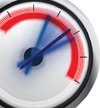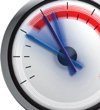Everything You Wanted to Know About Batch Processing
| As I mentioned in the chapter introduction, this chapter is going to consist of nothing but batch processing. Yep, one giant, humongous, tell-ya-everything-about-it chapter. I did this because I wanted to cover everything about batch processingevery setting, dialog, and even some troubleshooting tipsbecause it's one of the most misunderstood (but most powerful) tools in Photoshop. How to Use This ChapterBefore we start, I'll give you a quick rundown on how this chapter is going to go. I've broken the first tutorial up into sections based on the Batch dialog. We're going to go over everythingyes, I mean everything. That way, we make sure you know how to use each feature. After that, there's a tutorial that puts all of this information to use and walks you through a batch-processing sample. So, if you're the type that likes to put things together without reading the instruction manual, or will never stop and ask for directions when you're lost (come on, you know you're out there), then you can just jump to page 71 and start that tutorial. You can always refer back to the explanation part if you want more info on a specific setting. If you'd rather get a bird's eye view of the entire Batch dialog first, then start here. Sound good? Let's get to it. 
Starting a Batch ProcessOption OneThis one is my least favorite but I have to tell you about it anyway. In Photoshop, choose File>Automate>Batch. This will open the Batch dialog. When you use this method, you can choose a source folder of images to batch or you can choose to batch process any opened images. However, you can't select specific images from a folder or multiple folders (unless they're subfolders of the original folder).
Option TwoI recommend that you open Adobe Bridge and select the images you want to batch. You can even do a search that returns images from folders all over your hard drive, then batch all of them in one shot by choosing Tools>Photoshop>Batch. You just can't do that in Photoshop, which is why I recommend using Batch from Bridge. This will open the same dialog, except for the fact that the Source field will already have Bridge selected. You can also choose any of the other Source options that you can select when running Batch in Photoshop.  ©MATT KLOSKOWSKI Play (Choosing Which Action to Run)Once the Batch dialog is open, the first thing you'll need to do is pick which action you want to run in this batch. Set and Action: In the first section of the dialog, Play, choose which action you want to run from the pop-up menus. Choose the set that contains the action, and then choose the actual action itself from the Action pop-up menu. 
Source (Choosing Which Files to Batch)Depending on which option you used to open the Batch dialog, you may only have certain options here.  Folder: If you opened the Batch dialog from either Photoshop or Bridge, then you can choose a folder here. If you select Folder from the pop-up menu, then the Choose button below will become enabled and you can pick which folder you want to batch. Import: Choose Import to process images from a digital camera, scanner, or a PDF document. Opened Files: Use this option if you have all of the files you want to batch already open in Photoshop. Honestly, this probably won't happen too often and you may find you never use this option. Bridge: If you chose the Bridge method to launch the Batch dialog, then this field should already be populated with Bridge, and any selected photos will be batch processed. 
Override Action "Open" Commands: This is where a lot of people get confused. Many times, an action will contain an Open command. If it does, and you batch process multiple images using that action, it will open the same file every single time. Since that's probably not what you want, be sure to check this option and Photoshop will open only the images specified under Source. Include All Subfolders: Check this option if you've got more folders within the main Source folder you picked. Suppress File Open Options Dialogs: This option keeps any Open dialogs from popping up throughout the process (I highly recommend you check this option). For example, let's say you've got a bunch of Camera Raw files and you decide to batch process them to add a watermark and size them down for the Web. If you don't want the batch process to show the Camera Raw dialog for each photo and make you click Open, then you'll definitely want to choose this option. Suppress Color Profile Warnings: This is a lot like the previous option. This one by passes any color policy dialogs that may appear when opening an image. We've all seen this dialog and checking this option is the way to avoid it if you're batch processing.
Destination (Choosing How and Where to Save Your Files)Here you'll choose how and where you want to save your newly processed images. None: Choose None if your action opens and saves the files you need it to and you don't need to save them anywhere. Chances are it won't, so you'll probably barely ever use this option. Save and Close: This resaves the file in the same format and with the same settings as when it was opened, and closes it. Folder: Choose Folder if you'd like to save the images from the batch into a specific location, other than where they were opened from. If you select this option, the Choose button will become enabled, allowing you to pick a folder. Override Action "Save As" Commands: Checking this option will ignore the Save As commands in the action. For instance, let's say you saved your image for the Web with specific JPEG settings. You want your batch processed files to be saved with those settings; however, you don't want every single file to be saved using exactly the same name, so you'd go ahead and check this setting. File NamingIf you choose Folder as your destination, this section will become enabled. There's a lot of flexibility when it comes to naming the files here. Keep in mind that you can preview the proposed file name directly in the dialog, as well.
Document Name: You can choose to have the original document name (in lower, upper, or title case) included in your file name. Serial Number or Letter: You can also add an auto-incremented serial number or letter to the file name. Date: You can add the date to the file name, as well, in several different formats. Text: If you want to add your own custom text to the file name, just type into the field. Extension: This adds the file extension to your name in lower or uppercase. Compatibility: If you're creating files for the Web or you're moving them between a Mac and Windows, then it's best to check all options here. ErrorsYou have several choices when you run into errors when batch processing. Stop For Errors: This will stop the batch process and notify you of each and every error. Realistically, it's not the best choice, since if there are errors you're better off choosing the next option, Log Errors To File, and reviewing them all at the end. Log Errors to File: This logs all errors in a text file and allows the batch process to run all the way through. If you pick this option, then the Save As button will become enabled and you must pick a place for this error log text file to reside.
|
EAN: 2147483647
Pages: 113









